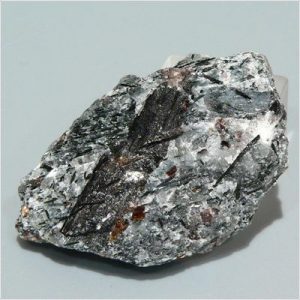Aenigmatite
Aenigmatite is a rare inosilicate mineral containing titanium, that is a member of the Aenigmatite Group of minerals that includes Aenigmatite, Krinovite, Kuratite and Wilkinsonite. Aenigmatite is primarily found in peralkaline volcanic rocks, pegmatites, and granites as well as silica-poor intrusive rocks. It was first described and named in 1865 by German mineralogist Johann Friedrich August Breithaupt (1791-1873) from an occurrence in the Ilimaussaq intrusive complex of southwest Greenland. The name Aenigmatite is from the Greek word αίνιγμα(aenigma), meaning a riddle, in allusion to the uncertain chemical composition of the mineral.
Aenigmatite is typically opaque, velvet-black in color with vitreous to greasy luster and often associated with bronze-brown Astrophyllite crystals. Faceted gems are very rare. Cabochons are somewhat more common but usually collected for their flashy bronze Astrophyllite crystals and the secondary black Aenigmatite crystals, if present, are not even mentioned.
In addition to the localities listed below, Aenigmatite was also reported from the Kaidun meteorite, possibly a Mars meterorite, which landed on a Soviet military base near what is now Al-Khuraybah in Yemen on December 3, 1980.
Aenigmatite distribution: notable studied occurrences include: at Naujakasik, near the Tunugdliarfik Fjord, and on the Kangerdluarssuk Plateau, in the Ilímaussaq intrusion; from Narssârssuk; and elsewhere in Greenland. In the Khibiny and Lovozero massifs, Kola Peninsula, Russia. At Sandefjord, Norway. From Cuddua Mida, Sicily, Italy. In the USA, from Granite Mountain, near Little Rock, Pulaski County, Arkansas, and Santa Rosa, Sonoma County, California. In Australia, from Warrumbungle volcano, Nandewar volcano, and the Mt. Warning complex, New South Wales; and the Peak Range Province, Queensland. From Logan Point quarry, Dunedin volcano, New Zealand.
| Chemical Formula: | Na2Fe52+Ti(Si6O18)O2 |
| Sodium Iron Titanium Silicate Oxide | |
| Atomic Number: | 1,717.59 gm |
| Molecular Weight: | 127.60 gm |
| Composition: | Sodium | 4.99 % | Na | 6.73 % | Na2O |
| Calcium | 0.77 % | Ca | 1.08 % | CaO | |
| Magnesium | 0.65 % | Mg | 1.08 % | MgO | |
| Zirconium | 0.05 % | Zr | 0.07 % | ZrO2 | |
| Titanium | 5.85 % | Ti | 9.77 % | TiO2 | |
| Manganese | 1.28 % | Mn | 1.65 % | MnO | |
| Aluminum | 1.01 % | Al | 1.90 % | Al2O3 | |
| Zinc | 0.04 % | Zn | 0.05 % | ZnO | |
| Iron | 29.95 % | Fe | 35.76 % | FeO / 3.07 % Fe2O3 | |
| Silicon | 18.15 % | Si | 38.83 % | SiO2 | |
| Oxygen | 37.26 % | O | |||
| 100.00 % | 99.99 % | = TOTAL OXIDE |
| Crystallography: | Triclinic – Pinacoidal |
| Crystal Habit: | Crystals poorly developed, prismatic, to 8 cm; as irregular segregations. |
| Twinning: | By rotation ⊥ (011) or about [010] of the pseudomonoclinic cell; polysynthetic |
| Cleavage: | Good on {010}, {100} |
| Fracture: | Irregular/Uneven |
| Tenacity: | Brittle |
| Moh’s Hardness: | 5.5 – 6.0 |
| Density: | 3.81 (g/cm3) |
| Luminescence: | None |
| Radioactivity: | Not Radioactive |
| Color: | Velvet-black; in thin section, reddish brown to black |
| Transparency: | Translucent to opaque |
| Luster: | Vitreous to greasy |
| Refractive Index: | 1.780 – 1.900 Biaxial ( + ) |
| Birefringence: | 0.090 – 0.100 |
| Dispersion: | Very strong; r < v |
| Pleochroism: | X = yellow brown; Y = red-brown; Z = dark brown to black |


